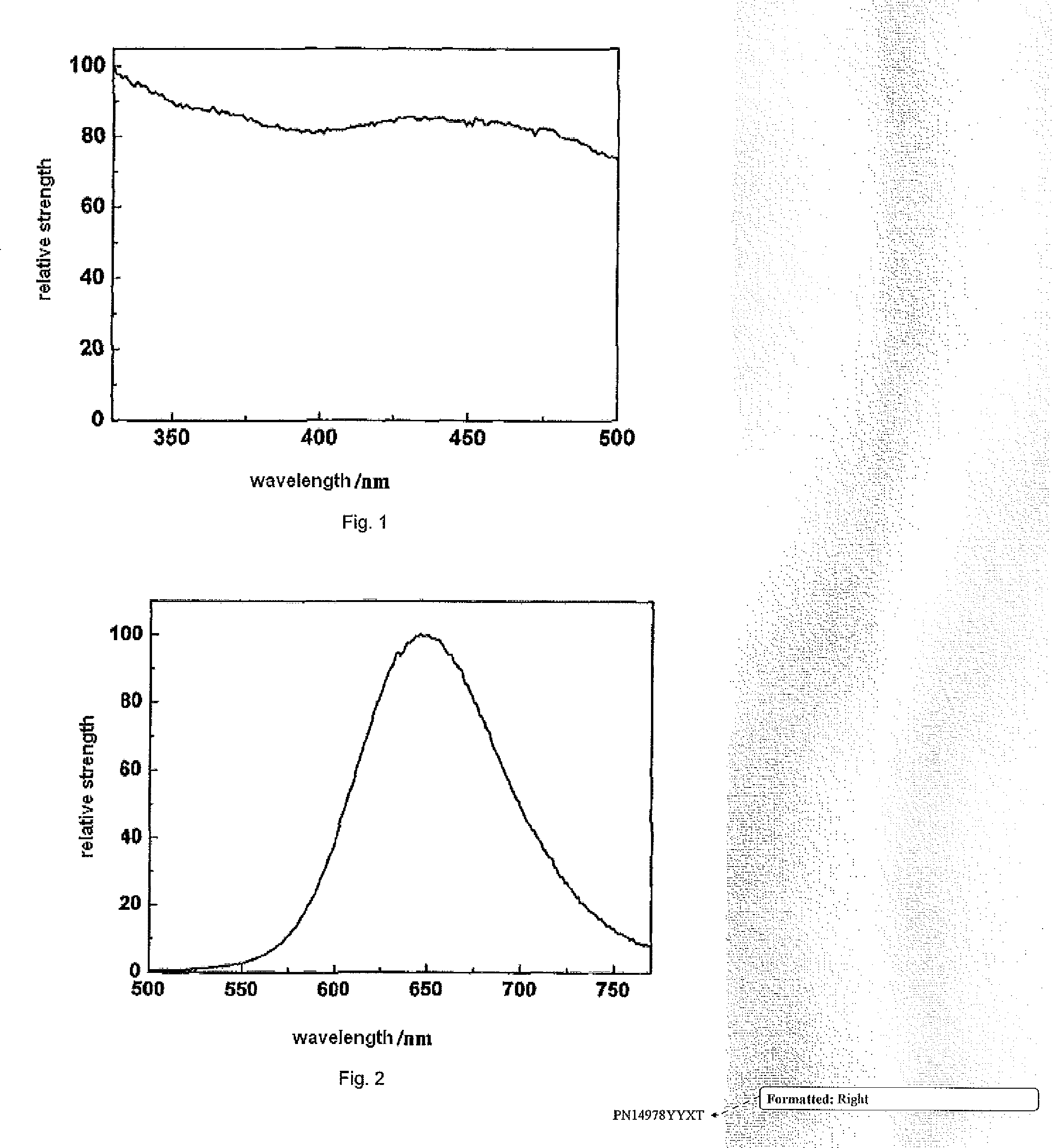Light emitting diode (LED) red fluorescent material and lighting device having the same
- Summary
- Abstract
- Description
- Claims
- Application Information
AI Technical Summary
Benefits of technology
Problems solved by technology
Method used
Image
Examples
embodiments 1 to 6
[0039]It is predetermined that the molar ratios of the elements in the fluorescent materials of the embodiment 1 to the embodiment 6 are:
[0040]Embodiment 1 Ca:Al:Si:Eu:Se:S=0.992:1:1:0.008:0.00001:0.00003
[0041]Embodiment 2 Ca:Al:Si:Eu:Se:Te=0.992:1:1 :0.008:0.0001:0.00002
[0042]Embodiment 3 Ca:Al:Si:Eu:Se=0.992:1:1:0.008:0.001
[0043]Embodiment 4 Ca:Be:Al:Si:Eu:Se=0.99:0.002:1:1:0.008:0.005
[0044]Embodiment 5 Ca:Mg:Al:Si:Eu:Se=0.991:0.001:1:1:0.008:0.01
[0045]Embodiment 6 Ca:Ba:Zn:Al:Si:Eu:Se=0.981:0.01:0.001:1:1:0.008:0.02.
[0046]Silicon nitride which contains 0.96 wt % of oxygen and has an average particle size of 0.4 μm, aluminum nitride which contains 0.6% of oxygen and has an average particle size of 1.3 μm, europium nitride, calcium nitride, beryllium nitride, magnesium nitride, barium nitride, element selenium, element tellurium and element sulfur are selected as raw materials. The raw materials are weighed according to the proportions above and mixed uniformly. The temperature of ...
embodiments 7 to 12
[0049]Silicon nitride, aluminum nitride, europium nitride, calcium nitride, element selenium, gallium nitride, yttrium nitrate, lutetium oxide, lanthanum oxide, gadolinium hydroxide, boric acid, scandium oxide, and indium nitride are selected as raw materials in the present embodiments. The proportions of raw materials of each embodiment are based on the element molar ratios as shown in Table 3. The synthesis and post-treatment techniques of the fluorescent materials are the same as those from the embodiment 1 to the embodiment 6 and photochromic data of the obtained series of fluorescent materials is as shown in Table 3.
TABLE 3Photochromic data of the series of fluorescent materialsobtained from the embodiment 7 to the embodiment 12RelativeMainbright-peak / Element molar rationess / %nmEmbodimentCa:Al:B:Si:Eu:Se =8962870.4999:0.499:0.001:0.5:0.0001:0.0001EmbodimentCa:Al:Ga:La:Si:Eu:Se =10563280.999:0.997:0.002:0.001:1:0.001:0.0001EmbodimentCa:Al:Si:Eu:Se =128641.890.992:1:1:0.008:0.000...
embodiments 13 to 17
[0050]In this group of embodiments, the molar ratios of the elements are: Ca:Al:Si:Eu:Se=0.992:1:1:0.008:0.001. The differences among the embodiments are that the contents of silicon carbide in the raw materials are different, and the mass percentages are 0.001%, 0.01%, 0.1%, 0.2% and 0.4%, respectively. The synthesis and post-treatment techniques of the fluorescent materials are the same as those from the embodiment 1 to the embodiment 6. Table 4 shows a detailed element analytical result (ICPS-7510 weight percentage) of the fluorescent material of the embodiment 15. There is 0.089% of carbon in the fluorescent material, and the relative brightness thereof is increased to different degrees compared with carbon-free fluorescent materials. However, excessive carbon content may result in defects because of too much carbon entering in the crystal lattices. At the same time, there will be impurity phase, thereby reducing the lighting intensity, as shown in Table 5.
TABLE 4Element analyti...
PUM
 Login to View More
Login to View More Abstract
Description
Claims
Application Information
 Login to View More
Login to View More - R&D
- Intellectual Property
- Life Sciences
- Materials
- Tech Scout
- Unparalleled Data Quality
- Higher Quality Content
- 60% Fewer Hallucinations
Browse by: Latest US Patents, China's latest patents, Technical Efficacy Thesaurus, Application Domain, Technology Topic, Popular Technical Reports.
© 2025 PatSnap. All rights reserved.Legal|Privacy policy|Modern Slavery Act Transparency Statement|Sitemap|About US| Contact US: help@patsnap.com

